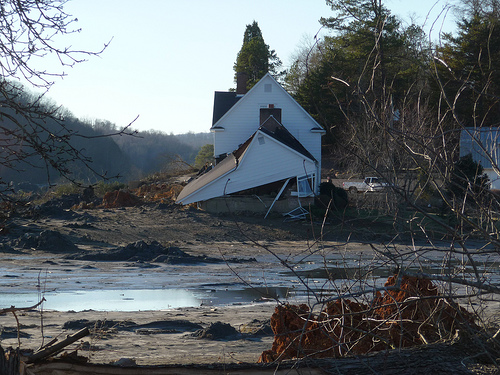This week’s blog post is co-written by Mary Anne Hitt, deputy director of the Sierra Club’s Beyond Coal Campaign.
If you lived near a dump site where the hazardous waste was so toxic it could increase your cancer risk to as high as a staggering 1 in 50, wouldn’t you want to know about it? What if there was one near your child’s school, but you had no way of knowing about it because the list of the most dangerous sites was being kept secret? Well, it turns out there are dozens of such sites across the nation, and our government is refusing to tell us where they are.
The toxic waste is coal ash, a byproduct of burning coal to generate electricity, the same black goo that devastated a Tennessee town last December when a Tennessee Valley Authority (TVA) dam failed and released 1 billion gallons of the heavy metal-laden sludge into area rivers.

photo credit Lyndsay Moseley
Today, the Sierra Club is joining with allies to demand the release of that information. We have formally asked the Obama Administration to make public the list of 44 the nation’s most hazardous coal ash disposal sites. The Freedom of Information Act request was submitted to the Department of Homeland Security (DHS), the Army Corp of Engineers and Environmental Protection Agency (EPA) by the Sierra Club, Earthjustice, the Environmental Integrity Project, and Natural Resources Defense Council.
This comes after last week’s refusal by EPA to disclose which of the nation’s hundreds of coal ash sites pose such a threat to nearby communities that they have been deemed classified (the locations of other hazardous sites, such as nuclear plants and Superfund sites, are publicly available).
Nevermind that already living near a coal ash waste site is threatening enough to one’s health and livelihood. Coal ash sites contain harmful levels of arsenic, lead, mercury and other toxins, which can leach out slowly contaminating drinking water sources, or as in the case of the 44 “high hazard” sites, flood nearby communities with a life-threatening wave of toxic sludge as happened last year in Tennessee. These dangers are yet another reminder of the need to clean up coal’s toxic legacy and speed up the transition to cleaner, safer energy sources
Senator Barbara Boxer was so outraged by last week’s refusal to disclose the list of sites that she held a press conference to let the public know that her staff had been “muzzled” and prevented from releasing the information. (video of Senator’s Boxers press conference here)
She has been leading the change in Congress to clean up these dangerous sites. She wants the public to have this information and is sending a letter to EPA, DHS, and the Army Corps to, in her words, “ask for further information on whether the public disclosure of coal ash waste sites is consistent with the treatment of other hazardous sites.”
Senator Boxer is very committed to the public’s right to know exactly where these sites are and then to demand action to make them safe At the press conference, she said that she had been permitted to call the Senators who have the most hazardous sites in their states, but that those Senators were only permitted to talk to electric utilities and first responders – they were not even allowed to tell members of their own staff!
This news comes as EPA prepares to draft new proposed rules to ensure safe disposal of coal ash. Even though EPA is still months away from announcing a proposed rule for regulating coal ash, the coal industry has already begun lobbying to prevent any meaningful action.
A coal-industry-backed “Dear Colleague” letter being circulated by Sens. Sam Brownback (R-KS) and Kent Conrad (D-ND), urges other Senators to oppose treating coal safely. Their proposal will preserve the status quo: ensuring coal ash is treated less responsibly than household trash. —This is the approach that led to the TVA disaster and it is inadequate.
We need to treat the waste as a hazardous substance and not take away the opportunities for residents of communities impacted by coal ash disposal to provide input on the decision-making process. Please email your Senators here to ask them not to sign onto this bad letter.
Clearly, coal ash is a hazardous substance and should be regulated as such. Under the current system, toxins like arsenic and selenium have leached into waterways of dozens of documented communities around the country—communities who now suffer from higher rates of cancer and other diseases, with cancer rates as high as 1 in 50 for those living near the worst sites. Communities have a right to know about the toxic hazards near their homes.
The TVA disaster and subsequent follow up investigations have shown that we need consistent and enforceable federal regulations to prevent future coal ash disasters. These regulations can promote coal ash recycling and protect the environment from toxic leaching at the same time. And the cost of these safer, more consistent standards would be marginal, only about $1 billion annually according to EPA estimates—that’s less than one-half of one percent of utility industry sales in 1999.
Yet the coal industry continues fighting for special treatment to keep them from cleaning up their dirty business. Coal use from cradle to the grave is dirty, dangerous, and damaging, and yet the coal industry is spending millions on lobbying to retain and create more loopholes for themselves.
They’re doing it with mountaintop removal coal mining, they’re doing it with coal ash, and they’re especially doing it when it comes to burning coal for power – the coal industry’s fingerprints are all over the American Clean Energy and Security Act as they try to weaken it every step of the way. EPA must retain the authority to regulate every part of the coal cycle, especially with regards to cleaning up older coal plants.


